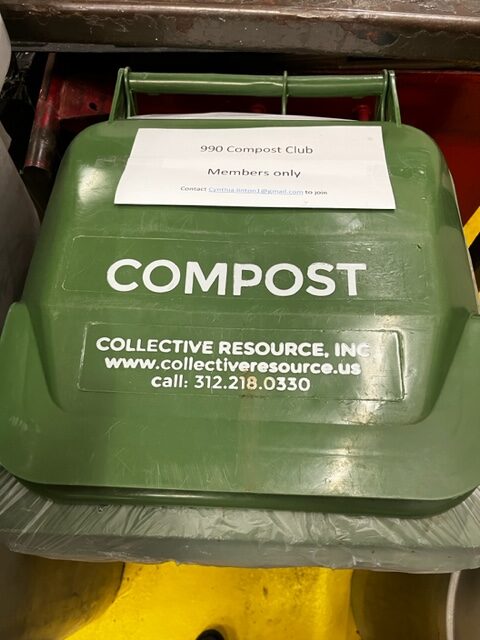
How to start composting from a high rise
By Cynthia Linton
My climate New Year’s Resolution for last year was to start composting and to try to bring along a few others in my high-rise building. That was one of the few personal actions I had not yet taken for the climate.
I began in earnest when I learned a friend in the building collected compost and took it to a drop-off place every couple of months. I had an ally! She then found someone else who was interested. Time to take action!
I offered to check out some local compost companies and select one. I had already had some contact with Urban Canopy and Collective Resource. Other options in Chicago include WasteNot Compost and Block Bins. I checked websites then called two companies. One never called me back, a bad sign. When I called Collective Resource, the person who answered the phone spoke at length with me, answered all my questions and offered to put me in touch with other customers as references.
I asked about whether they would come to a high-rise for just a few people, how much that would cost, and how the entire process worked. Other questions were about about kitchen bins, a large cart in the common area, frequency of pick-up, items they would accept, and whether they would provide a Zoom orientation.
I quickly decided Collective Resource met all my criteria. They were responsive, which is important since I am running this endeavor in the building. They take meat and dairy, which some do not. And they are reasonably priced ($26/pickup no matter how many times a month or how many residents participated). And they would meet with us on Zoom.
After a bit of legwork over about three months, including meeting with our condo board and inviting residents to join the project, we succeeded in getting a total of 10 units to join. Not bad, but that was less than 10% of the 150 units in our building.
The cart was delivered, a Zoom meeting with the company answered residents’ questions, and we were off and running. We had decided to start with two pick-ups a month. I put a sign on the cart saying “990 Compost Club, Members Only,” and to contact me to join.
We succeeded in getting a total of 10 units to join. I put a sign on the cart saying “990 Compost Club, Members Only.”
We didn’t want unacceptable items dumped in our compost bin or anyone else to use it, since 10 units were splitting the cost, and this seemed the best way to control access. The cost for the first three months was $35 per unit. I had offered to manage the billing to start, but the board said it might pick up the cost if we get enough participants.
My first load dumped in the cart included banana skins, coffee filters and grounds, broccoli stalks, orange rind, avocado skins and pits, salmon skin, some food-soiled paper towels, plus one avocado and one banana that had gone bad. It felt good to know all I dumped in the cart would become compost instead of going to a landfill.
You, too, can start composting in your apartment building
Setting up compost collecting in a multi-family building can be daunting. But it isn’t hard if you follow the necessary steps. To give you the benefit of my experience to help get you started, here are the steps I followed:
- Find an ally or two. It’s good to have someone else asking for board permission with you, and it’s fun to have a partner.
- Find a champion on the condo board. That person can support your ask and recommend how to go about asking for approval.
- Research local companies and pick one.
- Once you select a service, get at least one reference from a customer in a similar building. Also learn addresses of other nearby buildings that are customers. The board is likely to want that.
- Spend time explaining the composting process to the board champion and answer his/her questions. This gives good insight into questions the board may ask so you can be prepared. A main concern was odor.
- Plan a time to make your board pitch. I went to the half-hour comment period before a board meeting. I prepared a short speech and gave them each a packet with a list of what can be composted, appearance and dimensions of the cart in the common area, a reference letter, a map of the service area, and a list of FAQs and answers, developed with the company to answer expected questions.
- Get approval from the board to put a cart in the common area and to do a door drop to solicit interest. My board was receptive and wanted an update at the next meeting.
- Talk with the building manager about where to locate the cart and get her/his buy-in.
- Drop a half-page announcement at each resident’s door. It should ask if people want to join or just want more information.
- Arrange for delivery of the cart and a Zoom meeting with the company to orient those who want to participate. We targeted the week after New Year’s to start and began collecting in our own kitchen compost containers, which you can buy on Amazon and elsewhere. This is the one I purchased.
Feel free to contact me at cynthia.linton1@gmail.com for more information and help.
Let us know your story about composting at home in the comments below.
Other resources:
Composting in Apartments – an earlier post by Alex Parker
Illinois Food Scrap and Composting Coalition

Cynthia Linton is retired as a journalist and professor at the Medill School of Journalism at Northwestern University. She is a long-time activist who was trained by The Climate Reality Project in 2017 and is now Communications Chair of the Chicago Metro Chapter. She is grandmother or step-grandmother to six.


